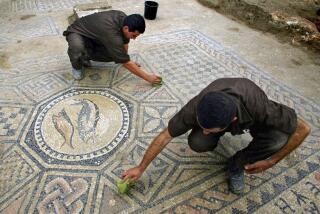âLucyâ tour gets no love from two U.S. museums
WASHINGTON â Plans for a six-year U.S. tour by âLucy,â one of humanityâs earliest known ancestors, have hit a major snag.
The Ministry of Culture and Tourism of Ethiopia and the Houston Museum of Natural Science last week announced an agreement to include Lucy in a tour of several hundred Ethiopian relics. But at least two major U.S. museums say the bones should not be moved, and they donât want to show them.
Rick Potts, the director of the Smithsonianâs Human Origins Program and a paleoanthropologist, said he and many other scientists agree that Lucy is too fragile to travel. He said the Ethiopian artifacts would not come to the Smithsonian.
A spokesman for the American Museum of Natural History in New York also said that the museum would not accept the 3.2-million-year-old fossilized remains.
The International Assn. for the Study of Human Paleontology, a group affiliated with UNESCO, passed a resolution in 1998 saying such fossils shouldnât be moved outside the country of origin. The resolution, unanimously approved by representatives of 20 countries, including Ethiopia and the United States, said replicas should be used for public display.
Potts, who has led major excavations in East Africa for more than 25 years, said fossils should be moved from their vaults âonly under the most compelling scientific reasons.â
Joel Bartsch, president of the Houston Museum of Natural Science, said there are no plans to cancel the tour. The museum is paying most of the costs and expects other museums will want to display the artifacts. The agreement calls for 11 venues, starting with Houston next September.
âI am quite confident all the slots will be filled,â Bartsch said. âI respect the opinions of the scientists, but museums travel irreplaceable, rare objects every day.â
He said his museum has shown the Dead Sea Scrolls, treasures from the Vatican and other fragile objects with no problems.
About 40% of a female skeleton was discovered near Hadar, Ethiopia, in 1974 by Donald Johanson and Tom Gray. Dubbed Lucy, she stood roughly 3 feet, 6 inches tall and weighed about 62 pounds. The bones are kept in a vault in the Ethiopian capital, Addis Ababa.
More to Read
Sign up for The Wild
Weâll help you find the best places to hike, bike and run, as well as the perfect silent spots for meditation and yoga.
You may occasionally receive promotional content from the Los Angeles Times.






